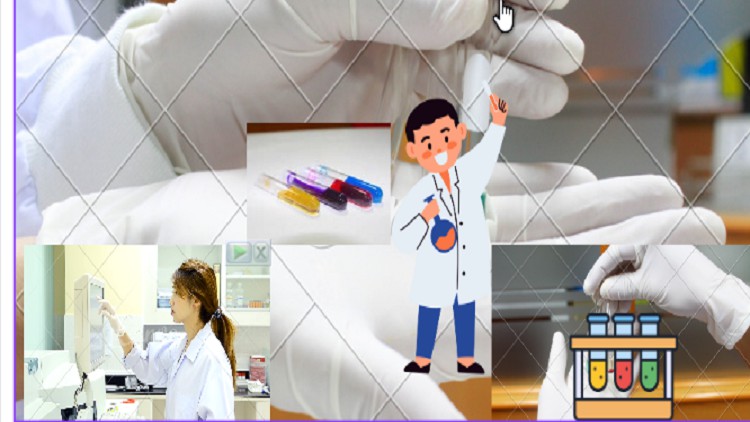
support diagnosis ,treatment and decision making in medicine
What you will learn
Description
Content
What you will learn
Description
Clinical laboratory science consists of various specialties such as clinical
chemistry, hematology, immunology, microbiology, serology, toxicology
and pathology
Clinical Chemistry is an exciting field that combines analytics and
instrumentation with information technology and management of workflow,
staff efficiencies and high volume automation. The field is ever-changing
and demands staff have skills in the methodologies and their limitations,
technology and troubleshooting equipment, as well as management and ability
to adapt operations to evolving clinical needs. At the heart, the laboratory is
a service to the physician providing test results that are critical to diagnosing
and managing patients. But, the laboratory is also a vital member of the
healthcare team and gets involved in utilization, operational efficiencies and
improving patient outcomes.
course contents
Introduction to clinical chemistry
analytes that are measured using clinical chemistry tests
Types of biologic specimens that may be used for testing
How the results of tests are interpreted
Measurement principales
optical (photometric)
and electrochemical (potentiometric) – that are most often used to
determine concentrations of analytes in the clinical chemistry laboratory.
he difference between an endpoint and a rate reaction
the principle of potentiometric measurement
Chemical reactions of analytes produce products that can be detected
by using optical methods; changes in light absorbed, scattered or
emitted by these products are used to determine the concentration of
the analyte.
2. In potentiometric methods, changes in concentrations of ions are
sensed as potential differences between two electrodes.
3. Calibrators, solutions of known concentration, are used to establish the
relationship between the magnitude of an optical or electrical signal
and the corresponding concentration of analyte.
Quantitation of routine chemistry analytes is typically based on one
of two measurement principles – measurement of light (photometry
or spectrophotometry) or measurement of electrochemical potential
(potentiometry). There are many variations of photometry and potentiometry, but all have in common that the signal
the amount of light or electrical voltage
is predictably related to the amount of analyte
in solution.
Accurate test result is our aim
Distinguish between precision and accuracy
• Describe how calibrator values are assigned
• Identify the roles of proficiency testing (PT)/external quality assurance (EQA)
and quality control testing programs in ensuring accuracy of test results
1. Laboratory tests must meet precision and accuracy standards.
2. Accuracy, closeness to a true value, depends on a valid calibration process.
3. Calibrator value assignment is linked to a certified reference material,
a recognized reference method or a consensus process that provides
“traceability”.
4. Laboratories use quality control and proficiency testing to monitor the
precision and accuracy of test methods.
Test for analytes in amixtures
Measurement of one substance when it is part of a complex mixture of substances
provides special challenges. A measurement method that works well for determining
the amount of an analyte in a relatively pure form may be completely unsatisfactory
when the analyte is in a mixture of cells, proteins, lipids, carbohydrates and trace
minerals. Methods for the analysis of analytes in complex biologic mixtures require
special approaches to minimize or eliminate interference from other substances. Some
of the approaches frequently used in clinical chemistry such as blanking, rate methods,
pretreatment, reagent specificity and ion-selective electrodes are described in more
detail in the following sections.
where you can find errors?
preanalytical, analytical and postanalytical errors
1. Patient preparation and proper collection and handling of specimens are
important preanalytical steps to ensure the validity of a test result.
2. Hemolysis, icterus and lipemia (HIL) are three of the most common sources
of interfering substances found in blood serum and plasma samples.
• Hemolyisis refers to color of hemoglobin released from destroyed red blood cells
• Icterus refers to color from bilirubin
• Lipemia refers to turbidity from high lipid concentrations, usually triglycerides
If unrecognized, their presence may cause overestimation or underestimation of
the analyte concentration.
3. Automated instrumentation includes numerous algorithms to detect potential
sources of error and alert the operator.
common clinical chemistry tests
1. Clinical chemistry tests measure a wide variety of analytes that reflect many
different organ systems and diseases.
2. Some test results are specific indicators for a single organ system or disease;
others are general indicators of a disease or disorder, but do not pinpoint the
specific organ or disease process.
3. Tests are performed for different reasons. Some tests help diagnose a disease,
others monitor the course of the disease progression or effectiveness of
therapy, and still others are used to screen for risk of developing a disease.
Hundreds of compounds, molecules and ions circulate in body fluids. Many of
these can be measured by tests used in clinical chemistry laboratories. These tests
are valuable in the prevention, diagnosis and treatment of disease.
some disases
Diabets millitus
choronic kidney failure
cardiac heart diseases biomarkers
Anaemia
Content
